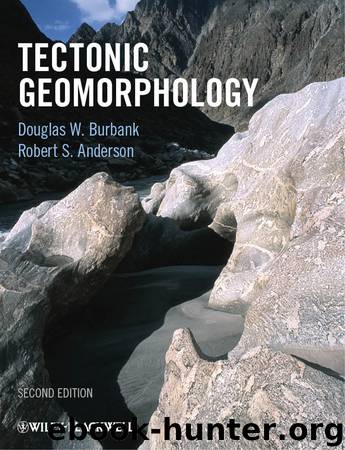Tectonic Geomorphology by Burbank Douglas W. Anderson Robert S. & Robert S. Anderson

Author:Burbank, Douglas W., Anderson, Robert S. & Robert S. Anderson
Language: eng
Format: epub
Publisher: John Wiley & Sons
Published: 2011-09-06T16:00:00+00:00
If the regime switches to one in which erosion prevails over tectonic thickening, such that the crust actually thins, then the reduced mass of the mountains will drive an isostatic uplift within the proximal foreland as well, as a function of the finite flexural rigidity of the crust (Fig. 7.27). Erosion will occur in the proximal foreland, and coarse-grained sediments may prograde as tabular, thin sheets across the medial and distal foreland (Heller et al., 1988). Transverse rivers can flow across nearly the entire foreland basin before merging with a longitudinal trunk stream, which may itself be pushed toward the far edge of the basin by the proximal rock uplift (Burbank, 1992).
Such a pattern appears to be consistent with the geometry of modern rivers in the Himalayan foreland (Burbank, 1992). Whereas, during Miocene times, coarse strata remained near the mountain front and axial rivers dominated the medial foreland basin, during Quaternary times, tabular sheets of strata extend across the medial and distal foreland, and transverse drainages stretch across the foreland. These changes suggest that the relative balance between crustal thickening and thinning has changed during the past few million years. If true, then uplift of summits observed today would represent an isostatic response to a reduction in the overall thickness of the crust.
Estimates of paleoaltitude
Determining the paleoaltitude of a surface or rock sample represents one of the biggest challenges facing anyone attempting to document uplift of surfaces in inland regions where markers referenced to sea level cannot be readily defined. For example, at an average modern elevation of 5000 m, the Tibetan Plateau is the highest region on Earth and has a major impact on global climate, sediment fluxes, and ocean chemistry. Despite its significance as a huge orographic feature, the timing and magnitude of uplift of Tibet are still highly controversial (Molnar et al., 1993; Murphy et al., 1997; Rowley et al., 2001), with estimates ranging from Cretaceous to Late Pleistocene for when the plateau nearly attained its present altitude. Similar controversy surrounds the timing of uplift or collapse of western North America and the Puna–Altiplano plateau in the Andes.
How does one determine how high some surface was in the past? One means to assess surface uplift is to study the growth of mountain ranges that impact local climatic conditions. The rise of moist air masses as storms approach the flanks of mountains causes orographic precipitation to be focused on the windward side of the range (Bookhagen and Burbank, 2010). In the lee of the range, a rain shadow commonly develops. If you could detect the development of a rain shadow, you might infer that a mountain range had grown in a windward position. For example, the Miocene aridification of the western part of the Basin and Range has been attributed to the rise of the Sierra Nevada in California (Axelrod, 1957) and its interception of moisture from Pacific storms that used to penetrate farther into the continental interior (Smith et al., 1992). Although this interpretation may be correct,
Download
This site does not store any files on its server. We only index and link to content provided by other sites. Please contact the content providers to delete copyright contents if any and email us, we'll remove relevant links or contents immediately.
| Geomorphology | Historical |
| Limnology | Physical |
| Plate Tectonics | Sedimentary |
| Specific Locations | Structural |
| Volcanology |
Man-made Catastrophes and Risk Information Concealment by Dmitry Chernov & Didier Sornette(4756)
The Revenge of Geography: What the Map Tells Us About Coming Conflicts and the Battle Against Fate by Kaplan Robert D(3607)
Zero Waste Home by Bea Johnson(3302)
COSMOS by Carl Sagan(2964)
In a Sunburned Country by Bill Bryson(2957)
Good by S. Walden(2926)
The Fate of Rome: Climate, Disease, and the End of an Empire (The Princeton History of the Ancient World) by Kyle Harper(2446)
Camino Island by John Grisham(2395)
A Wilder Time by William E. Glassley(2369)
Organic Mushroom Farming and Mycoremediation by Tradd Cotter(2316)
Human Dynamics Research in Smart and Connected Communities by Shih-Lung Shaw & Daniel Sui(2184)
The Ogre by Doug Scott(2125)
Energy Myths and Realities by Vaclav Smil(2073)
The Traveler's Gift by Andy Andrews(2021)
Inside the Middle East by Avi Melamed(1947)
Birds of New Guinea by Pratt Thane K.; Beehler Bruce M.; Anderton John C(1918)
Ultimate Navigation Manual by Lyle Brotherton(1773)
A History of Warfare by John Keegan(1726)
And the Band Played On by Randy Shilts(1626)
